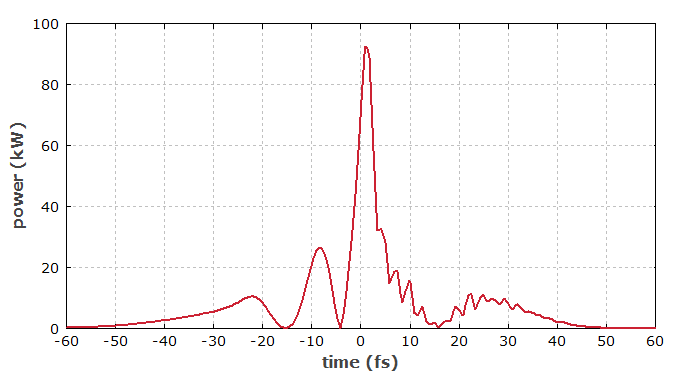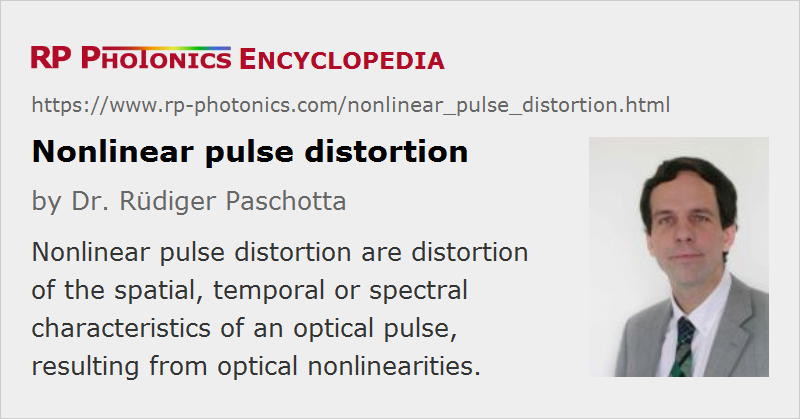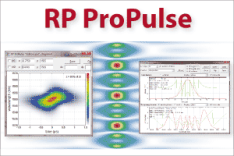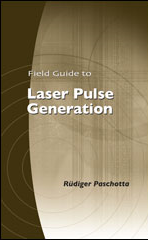Nonlinear Pulse Distortion
Definition: distortion of the spatial, temporal or spectral characteristics of an optical pulse, resulting from optical nonlinearities
German: nichtlineare Pulsverzerrung
Categories: fiber optics and waveguides, nonlinear optics, optical amplifiers, light pulses
How to cite the article; suggest additional literature
Author: Dr. Rüdiger Paschotta
Optical pulses, in particular ultrashort pulses with pulse durations of picoseconds or femtoseconds, can have very high peak powers and peak intensities even when the pulse energy is moderate, e.g. in the microjoule regime. As a consequence, such pulses can be strongly influenced by nonlinearities during propagation in transparent media, such as in laser crystals or particularly in optical fibers. Nonlinear effects can result in distortions of various kinds:
- For propagation in homogeneous media (e.g. bulk crystals), the spatial properties can be affected. An example is self-focusing, which can in extreme cases lead into laser-induced breakdown. In less extreme cases, one still has the effect of an aberrative and time-dependent lens.
- Strong spectral distortions can result from, e.g., self-phase modulation: the optical spectrum can acquire strong modulations and broadening.
- The temporal shape of a pulse can also be distorted: the pulse may be broadened, may become asymmetric, and or acquire temporal pedestals. In extreme cases, a pulse can break up into multiple pulses. An example is higher-order soliton fission in the process of supercontinuum generation. A related phenomenon is wave breaking. In many cases, the temporal distortion is not the direct impact of a nonlinearity, but rather the consequence of chromatic dispersion acting on a pulse with nonlinearly broadened optical spectrum. For example, self-phase modulation (in an approximation not containing the effect of self-steepening) or Raman scattering do not directly affect the temporal shape, but modify the optical spectrum so as to make a pulse significantly more susceptible to the effects of chromatic dispersion.
In amplifiers, the effect of gain saturation can also lead to substantial distortions of the temporal pulse shape: while the leading wing of the pulse experiences strong amplification, later parts are less strongly amplified as the gain is saturated already.

The nature of nonlinear pulse distortions depends strongly on the circumstances, i.e., the type and strength of nonlinearity and on the occurrence of other effects such as chromatic dispersion or waveguiding. It can be investigated with pulse propagation modeling.
There are various methods to mitigate nonlinear pulse distortions, e.g. in amplifiers for ultrashort pulses. Examples are the use of thin (and highly doped) amplifier crystals, chirped-pulse amplification and divided-pulse amplification.
Questions and Comments from Users
Here you can submit questions and comments. As far as they get accepted by the author, they will appear above this paragraph together with the author’s answer. The author will decide on acceptance based on certain criteria. Essentially, the issue must be of sufficiently broad interest.
Please do not enter personal data here; we would otherwise delete it soon. (See also our privacy declaration.) If you wish to receive personal feedback or consultancy from the author, please contact him e.g. via e-mail.
By submitting the information, you give your consent to the potential publication of your inputs on our website according to our rules. (If you later retract your consent, we will delete those inputs.) As your inputs are first reviewed by the author, they may be published with some delay.
See also: nonlinearities, Kerr effect, pulse propagation modeling, chirped-pulse amplification
and other articles in the categories fiber optics and waveguides, nonlinear optics, optical amplifiers, light pulses
 |







If you like this page, please share the link with your friends and colleagues, e.g. via social media:
These sharing buttons are implemented in a privacy-friendly way!